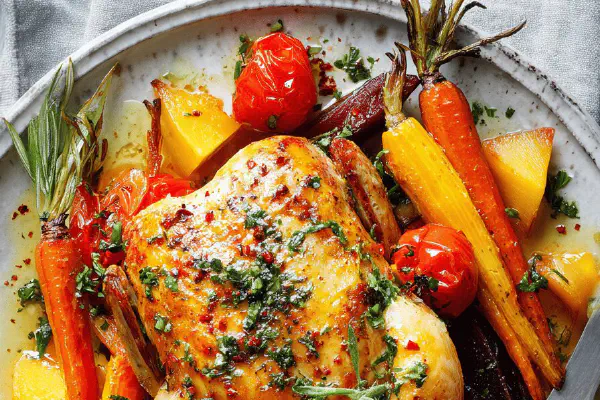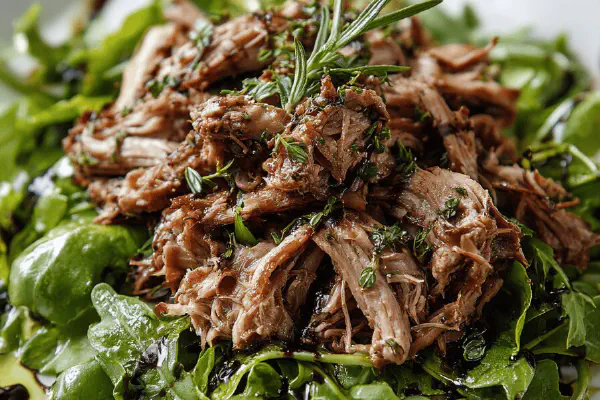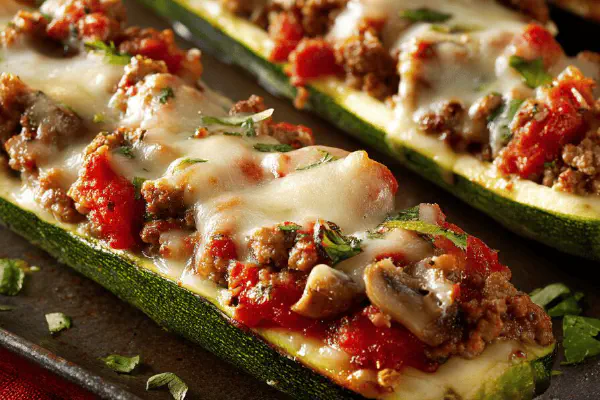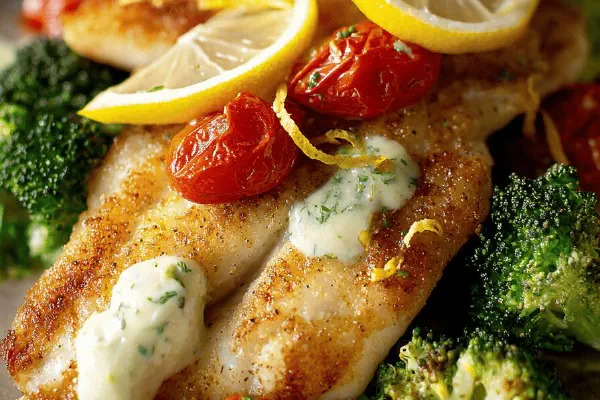Chicken Roulades Autumn Veg
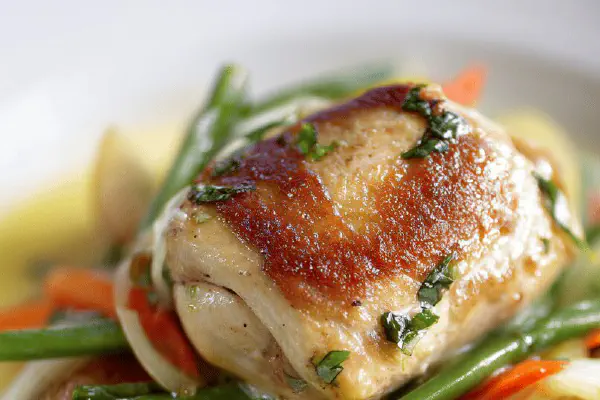
By Emma
Certified Culinary Professional
Ingredients
- 6 small fingerling potatoes, quartered
- 1 medium kohlrabi, peeled and julienned
- 25 green beans, trimmed
- 3 medium carrots, peeled and julienned
- 1 stalk celery root (celeriac), peeled and julienned
- 1 leek white part only, sliced thin julienne
- 4 boneless skinless chicken breasts
- 20 ml olive oil (1 1/3 tbsp)
- 75 ml cold unsalted butter cut into cubes
- 2 shallots minced finely
- 25 ml white wine vinegar (1 2/3 tbsp)
- 25 ml dry white wine
- Salt and cracked black pepper
About the ingredients
Method
- Vegetables first—blanch green beans and carrots separately in salted boiling water until al dente, about 3-4 minutes. Shock in ice water immediately to keep colours bright, drain thoroughly. Repeat with kohlrabi and celery root; these take slightly less time, watch for just tender bite.
- Fingerlings take longer—boil whole until just tender but still holds shape, roughly 10 minutes, then drain and quarter once cool enough to handle.
- Pat chicken dry on a sturdy board. Butterfly each breast, slice horizontally almost through, open like a book—aim for a rectangular shape for even rolling. Cover with plastic wrap, bash gently with a rolling pin or mallet to even thinness but not paper-thin. Season both sides: salt, black pepper, no mercy.
- Layer half of carrots and celery julienne in the lengthwise center strip of each breast. Reserve other half veggie mix separately for plating.
- Roll chicken tightly over filling, secure firmly with toothpicks or kitchen twine—key is tightness here, else filling escapes during cooking.
- In a large heavy skillet, warm olive oil plus 15 ml butter over medium-high. When butter foams, add roulades seam side down. Sear undisturbed about 5 minutes until deeply golden, then turn to brown all sides evenly, about 5 more minutes total. It should feel springy but firm when pressed. Don’t hurry; lock juices in. Remove roulades and tent loosely to rest.
- Discard fat leaving fond in pan, add shallots chopped fine, soften gently over medium heat—should turn translucent, not brown, around 2 minutes. Now deglaze pan with vinegar and wine, scrape up all brown bits. Let it reduce until almost dry, aromatic sharpness fades but brightness stays.
- Off heat, whisk in cold butter cubes gradually, swirl vigorously to emulsify sauce. Don’t let it boil or split; sauce will be glossy and coat spoon smoothly. Season final with salt and pepper to taste.
- While sauce emulsifies, gently reheat reserved vegetables (carrots, celery, leeks) in a splash of water or butter, just warmed through to keep crispness. Fingerlings can go into warm pan briefly too.
- Remove toothpicks. Slice roulades diagonally into 2 halves. Plating: mound veggies centered on each plate, arrange roulade halves leaning slightly. Spoon sauce over roulades and around for shine and flavor.
- Serve immediately. Texture should be tender chicken with a slight snap in vegetables, butter-wine sauce cutting through richness with a touch of acidity.
Cooking tips
Chef's notes
- 💡 Blanch veggies separately to nail texture. Green beans snap; carrots soften with crunch; kohlrabi and celery root tender but bitey. Timing stands out here. Shock immediately in ice water or colors dull and texture shifts quick.
- 💡 Butter cold and cubed is non-negotiable for sauce. Add too warm and sauce breaks. Whisk off heat, slow steady swirl builds glossy sheen classic to beurre blanc. Rushing wrecks it. Keep an eye on pan temp to avoid scorching vinegar sharpness.
- 💡 Butter-oil combo raises smoke point. Pure butter burns fast at sear temps. Olive oil tempers and melds with butter flavor. Sear seam side down first, undisturbed till deep golden crust forms. Gentle pressing tests readiness — springy not mushy.
- 💡 Chicken rolled tight keeps filling inside. Use toothpicks or kitchen twine to lock. Loose roll leaks juices and filling, dry meat follows. Bash breast thin but not paper thin — aim uniform thickness for even cook; thick spots undercook, thin spots dry out.
- 💡 Sauce reduction signals subtle. Vinegar sharpness softens but brightness remains. Pull reduction too late — sauce tastes vinegary or splits. Too early — watery bland. Scrape brown bits for deep flavor, then hit it off heat with butter cubes gradually.
Common questions
How to prevent roulades falling apart?
Roll very tight. Secure toothpicks or twine used. Fillings can squeak out if loose. Pat chicken dry first for better adhesion. Resting after sear firms shape, don’t skip that.
Can I swap veggies?
Yes but texture and cook times differ big. Root veggies julienned keep crunch. Avoid mushy or watery swaps. Kohlrabi and celeriac key for earth-sweet notes. Sub vinegar with apple cider but reduce qty, acidity differs.
What if sauce splits?
Whisk cold water spoon in vigorously off heat. Add cold butter cubed slowly next. Control temp low always. If separated fat floats, rewarm gently and keep whisking slowly. Hot pan wrecks emulsify fast.
How to store leftovers?
Store roulades sliced or whole covered. Sauce separate or on top but might thicken cold. Reheat gently in pan, avoid high heat to preserve moisture and avoid drying chicken or breaking sauce.
